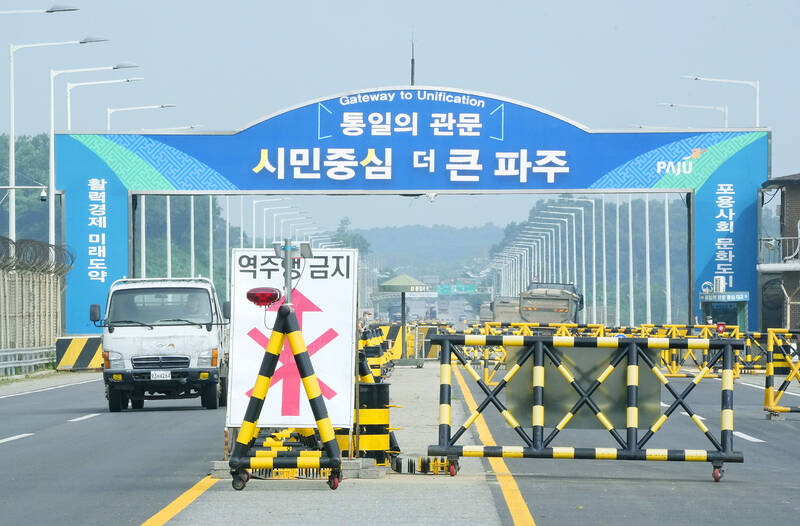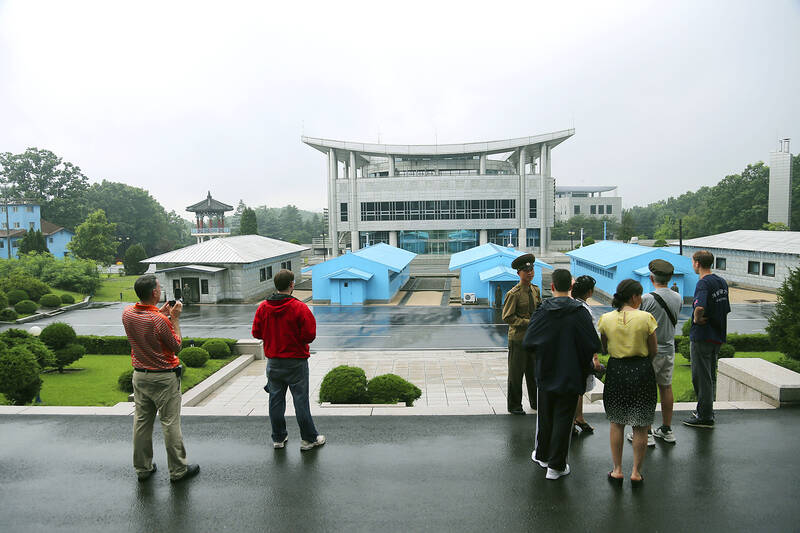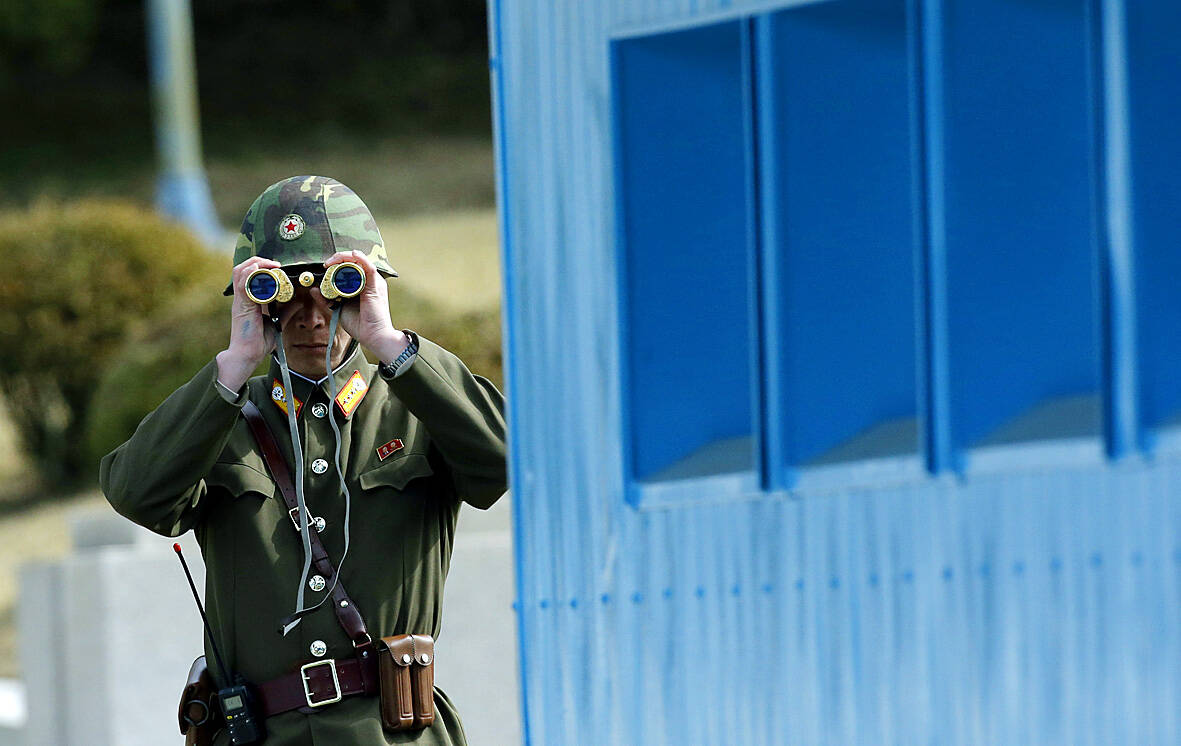Low-slung buildings, blue huts and somber soldiers dot the border village of Panmunjom inside the DMZ, or demilitarized zone, the swath of land between North and South Korea where a US soldier on a tour crossed into the North under circumstances that remain unclear.
The soldier was on a tour of the storied border town, inside the heavily fortified 248-kilometer-long DMZ, when the crossing happened, US officials said Tuesday. It remained unknown what prompted the soldier’s actions or what the motivations might have been. The soldier was believed to be in North Korean custody.
The DMZ is lined with observation posts on both sides, whose soldiers watch the border and each other carefully for any signs of transgression. North and South Korea remain technically in a state of war since the hostilities in Korean War ended and an armistice was signed — at Panmunjom — in 1953. Neither nation has direct jurisdiction over Panmunjom, where a concrete slab divides the two nations.

Photo: AP
North Korea, whose formal name is the DPRK, or the Democratic People’s Republic of Korea, maintains tight controls on entry and has been known to punish those who illegally cross the border from South Korea into its territory. Not all of the frontier with South Korea is as strictly patrolled as the DMZ around Panmunjom, though it is unclear how intensively the North patrols its side in more remote areas.
The North under the Kim family and the third-generation current leader, Kim Jong-un, is a tightly controlled society, and very few Americans are in the country at any given time; the two countries have no diplomatic relations and typically conduct any necessary diplomacy through third countries.
While the South Korean side of the DMZ brings in frequent tourists, few North Koreans have ever ventured either to or near their side of the heavily fortified DMZ. On the South Korean side, though, the different areas where tourists are welcomed sometimes take pains to put on a positive spin, with colorful ribbons tied to railings and the occasional ribbon-wielding dancer performing not far from barbed wire and stone-faced soldiers. Cameras are OK in some locations and prohibited in others.

Photo: AP
During the politically inflected 2018 Olympics in the South Korean town of Pyeongchang, journalists were shown the baby blue-colored room in Panmunjom that’s the only spot where high-level talks are held between the two countries. In the room was a large wooden table where talks are held. The border runs right down the middle of it.
At one point during another 2018 visit at another site along the DMZ, an AP illustrator was sketching the view below when a South Korean soldier came over and tore four pages from his book.
Tours to the southern side of Panmunjom reportedly drew around 100,000 visitors a year before the pandemic, when South Korea restricted gatherings to slow the spread of COVID. The tours resumed fully last year.

Photo: AP
There have been a small number of US soldiers who went to North Korea during the Cold War, including Charles Jenkins, who deserted his army post in South Korea in 1965 and fled across the DMZ. He appeared in North Korean propaganda films and married a Japanese nursing student who had been abducted from Japan by North Korean agents. He died in Japan in 2017.

On April 26, The Lancet published a letter from two doctors at Taichung-based China Medical University Hospital (CMUH) warning that “Taiwan’s Health Care System is on the Brink of Collapse.” The authors said that “Years of policy inaction and mismanagement of resources have led to the National Health Insurance system operating under unsustainable conditions.” The pushback was immediate. Errors in the paper were quickly identified and publicized, to discredit the authors (the hospital apologized). CNA reported that CMUH said the letter described Taiwan in 2021 as having 62 nurses per 10,000 people, when the correct number was 78 nurses per 10,000

As we live longer, our risk of cognitive impairment is increasing. How can we delay the onset of symptoms? Do we have to give up every indulgence or can small changes make a difference? We asked neurologists for tips on how to keep our brains healthy for life. TAKE CARE OF YOUR HEALTH “All of the sensible things that apply to bodily health apply to brain health,” says Suzanne O’Sullivan, a consultant in neurology at the National Hospital for Neurology and Neurosurgery in London, and the author of The Age of Diagnosis. “When you’re 20, you can get away with absolute

May 5 to May 11 What started out as friction between Taiwanese students at Taichung First High School and a Japanese head cook escalated dramatically over the first two weeks of May 1927. It began on April 30 when the cook’s wife knew that lotus starch used in that night’s dinner had rat feces in it, but failed to inform staff until the meal was already prepared. The students believed that her silence was intentional, and filed a complaint. The school’s Japanese administrators sided with the cook’s family, dismissing the students as troublemakers and clamping down on their freedoms — with

As Donald Trump’s executive order in March led to the shuttering of Voice of America (VOA) — the global broadcaster whose roots date back to the fight against Nazi propaganda — he quickly attracted support from figures not used to aligning themselves with any US administration. Trump had ordered the US Agency for Global Media, the federal agency that funds VOA and other groups promoting independent journalism overseas, to be “eliminated to the maximum extent consistent with applicable law.” The decision suddenly halted programming in 49 languages to more than 425 million people. In Moscow, Margarita Simonyan, the hardline editor-in-chief of the